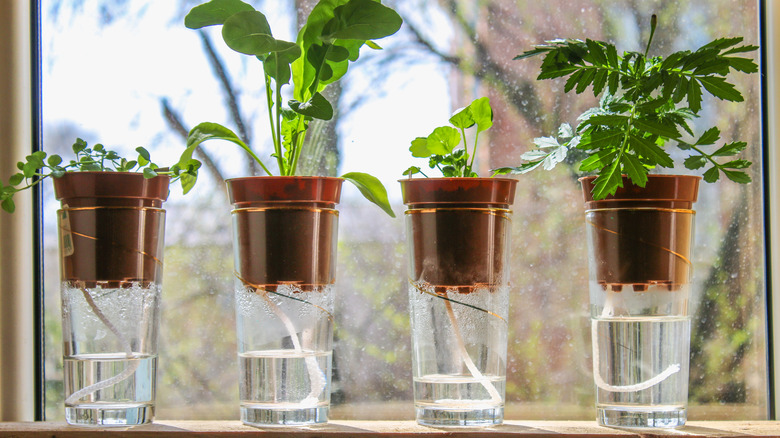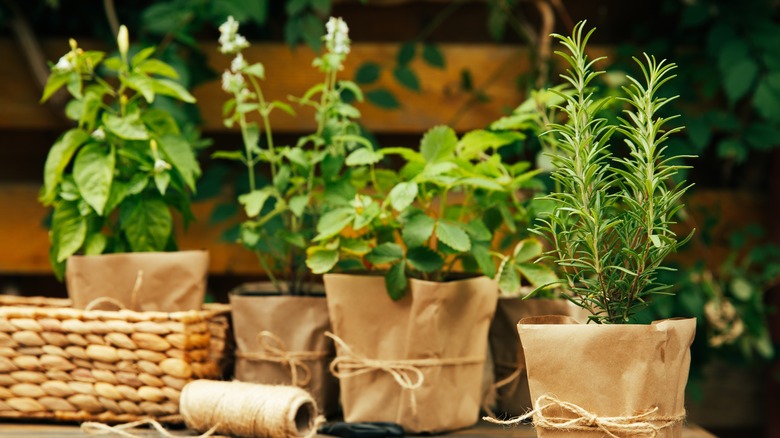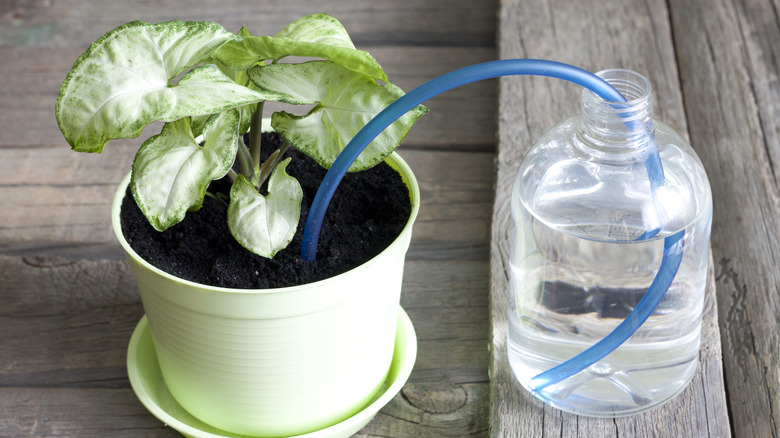The Water Bucket Hack To Keep Indoor Fresh Herbs Thriving
Herbs are expensive and difficult to store. How many times have you had a recipe call for three different kinds of herbs, only to realize that you only need a single strand of each? Then you're stuck with nearly-full bundles of leftover herbs that wilt alarmingly quickly, even when stored correctly (e.g., like a bouquet of flowers, with the stems cut and placed in a cup of water in your fridge).
Many people attempt to get around this costly and wasteful exercise by growing their own herbs, which can be a headache in itself. First, you have to make sure that the plants receive the right amount of sunlight, which varies per plant. Then, there's the challenge of making sure your roommate's cat won't just dig them up or knock them over. Maybe you received a cute pot from a friend only to realize that it didn't have drainage holes, leading to a situation where your plant could drown in its own moldy soil.
However, the most challenging aspect of growing herbs is managing their watering schedule, particularly if you need to go out of town for any length of time. Fortunately, there is a simple way to get your plants to water themselves, using only a bucket and a handful of string. The wick will keep your herbs watered, leaving them nice and hydrated.
The wick-watering method
The wick-watering method involves purchasing a bundle of 100% cotton string or rope. Look for the absorbent kind you might use for candles, torches, or even a clothesline. It's inexpensive, versatile, and might just save your plants' lives.
To begin, arrange your plants around a bucket of water as closely as possible, and feed one end of a wick into the water bucket. Take the other end and insert it just below the surface of your plant's soil, leaving no slack between the pot and the water source. Your herbs will draw the water down through the wick like a straw, watering themselves while you're away. This method is similar to placing an upturned, capped wine bottle (with a small hole in the cap) full of water into the soil of a large plant, but it's more effective for smaller plants, like herbs.
If your plants are situated in a particularly hot and sunny spot, try positioning your water source above them. This ensures that gravity assists in getting some of that water down the pipe; otherwise, it might simply evaporate in the sun.
Wick-watering pots
The best part about using the wick-watering method for herbs is that it allows all of your plants to receive the water they need. You won't have to figure out a complicated watering rotation to satisfy your thirsty basil, your low-maintenance thyme, and your middle-of-the-road Goldilocks cilantro.
If you want to get really fancy with it, consider purchasing a self-watering plant pot. Many nurseries and brands offer plant pots with built-in reservoirs at the bottom that you can fill up with water. Then, a smaller pot is fitted on top, with a wick inserted so that the plant absorbs water through the wick from the reservoir below. These pots are sometimes even more aesthetically pleasing than the DIY version, but you will need to manually check to see if the water in the reservoir is running low. Either way, the wick-watering method is extremely effective, and will leave your herbs healthy, happy, and ready for the next round of flavorful chimichurri or pesto.



